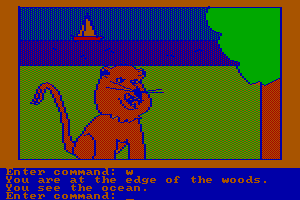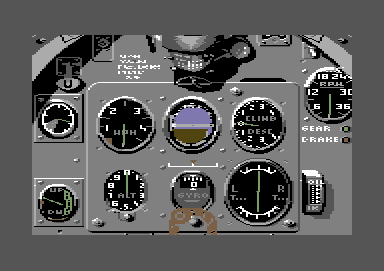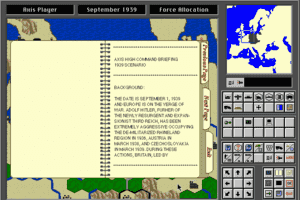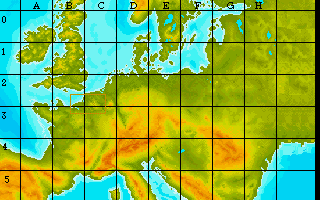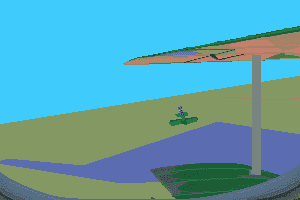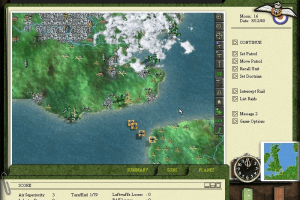Description of Achtung Spitfire
Their Finest Hour?
Last year's release of Over the Reich by Avalon Hill and Big Time Software garnered quite a bit of positive press for its incorporation of a realistic flight engine into a game that didn't ride the real-time wave. Far from being a competitor to Warbirds, OtR instead chose to treat wargamers to a turn-based game that, in its splendid false-3D graphics and complex modeling of aircraft performance, provided some of the atmosphere of a flight sim while allowing a player to fly multiple aircraft at the same time as one would do in a boardgame. Here at the GDR, though, David Kurtz's review was somewhat mixed in its reaction. "So what?" you say? This isn't a review of OtR? You're right: it isn't. However, the release of Achtung Spitfire seems to be a direct response to the success of OtR, and much of the same praise won by the predecessor game is now being lavished on Achtung Spitfire. Does it deserve it? The game engine is virtually unchanged, after all. Once you finish reading this review, you might just want to peruse David's OtR piece. It seems that, once again, the GDR is left with some reservations.
Not Without Precedent
David's OtR review commented on the game's resemblance to the old Air Force/Dauntless boardgame/expansion published many years ago by Avalon Hill. Some people might be surprised to learn that both Over the Reich and Achtung Spitfire are in fact boardgame conversions: both games were designed by J.D. Webster and published a few years ago by Clash of Arms Games, a small company best known for rescuing the "La Bataille..." series of Napoleonic wargames after the demise of Marshall Enterprises. Webster is a former US Navy pilot and the author of Game Designers' Workshop's well-known jet combat boardgame Air Superiority, as well as another jet game published by Clash of Arms called The Speed of Heat. The boardgame versions of OtR and AS are quite sophisticated in their own right, and the computer versions reflect this in their wealth of detail regarding aircraft performance as well as in a flight engine that takes very seriously the challenge of modeling three-dimensional movement in what is really a two-dimensional mapboard. From the outset, these games are marketed towards experienced wargamers. People who are solely action buffs or flight sim fanatics had most certainly better look elsewhere.
If The British Empire
Achtung Spitfire is billed as the "prequel" to Over the Reich since it covers the time period from 1939-1943, which immediately precedes the time period of OtR. The games share the same interface and flight engine, though, so anyone who owns OtR will feel immediately at home. The game includes the R.A.F., the Luftwaffe, and the French Armee de l'Air, with campaign games for all three. There are numerous scenarios, and one can always design more using the scenario builder function. At first glance, it would seem that this is the perfect companion to OtR, and the above features -- as well as the ability (after installing the v1.13 patch) to transfer pilots from AS to OtR in 1943 and continue a Tour of Duty that can encompass the entire war -- mean that if you own and enjoy OtR, you should stop reading right here, get up, and buy the game right now (if you haven't already). Move along, move along - there's nothing to see here.
Those who are not already devoted fans of these two games might want to read further, though, as I have concerns about several aspects of Achtung Spitfire. In fact, the first of these concerns is so serious that I nearly took the entire game back to the store whence it was purchased to demand my money back. This plan of action, which I discarded only after about thirty minutes of sitting in front of my computer, seething, was engendered by my opening the game box and finding the CD, a thin game "guide," and ... a lot of air. I was dumbfounded, and at first thought perhaps that my copy had been improperly assembled and the full "manual" forgotten. Only after a few seconds did it dawn on me that Avalon Hill had done it again: in keeping with some bizarre philosophy which postulates that the less people know, the better, they had done with Achtung Spitfire what had been done with Wooden Ships & Iron Men and Over the Reich: they had left players to "figure it out" on their own. With this stunning omission, AH exclude all of the information necessary to fly the aircraft. The description of the rules in the boardgame version takes over forty full-sized, closely spaced pages. While it is true that much much more space is required to write the rules in a manner that players of the boardgame can follow without any ambiguity than it is to simply describe how the flight engine works while allowing the computer to keep track of the rules, the sheer size of the rulebook that comes with the boardgame illustrates the complexity of the flight modeling in Achtung Spitfire. Shortchanging the player like this is inexcusable.
Faced with this dilemma, I retrieved the boardgame's rulebook and proceeded to try to compare the effects of manipulating the flight interface on the computer with the rules as stated in the rulebook. The manual states that the game scale is 100 yards per unit of range, and 4.1 seconds per turn. This is exactly the same scale as the board game (with a "unit of range" in the board game being one hex), so perhaps some comparisons could be made. Unfortunately, the lack of a hex grid on the computer map made it difficult to verify anything, as the boardgame allows aircraft to move along hex spines as well as through hexes. In addition, it appears that at a given airspeed, the number of movement points available to an aircraft in the boardgame is not quite the same as that for an aircraft in the computer game. The basic system in the boardgame converts aircraft speed into a certain number of Flight Points (FPs). Each FP represents 50mph of speed (with half FPs being possible). These can be expended either as Horizontal Flight Points (HFPs) or Vertical Flight Points (VFPs). When expending climbing or diving, a single VFP can be used to gain or lose several "increments" of altitude (100 feet per). Banking is done through the expenditure of "Banking FPs." So far, everything sounds exactly like every other air combat game ever designed. What makes Achtung Spitfire, the boardgame, so interesting is how seamlessly the whole system seems to follow from these simple concepts. Climbing, diving, and turning by various degrees confer accel or decel points, which are used to determine the next turn's speed, and thus FPs. This is all nicely presented in the manual that comes with the boardgame, from which the following is an excerpt:
Not the greatest paragraph in terms of style, but it does contain a useful explanation of the physical forces at work followed by an outline of the factors involved in calculating decel points. The rules go on for another entire column (eight or nine short paragraphs) and explain how to use the appropriate aircraft data tables to calculate decel, as well as how decel affects movement. This kind of thing, re-written in a slightly less rigorous way (since, unlike in the boardgame, the players will not have to use the rules to adjudicate the game) would have done wonders for Achtung Spitfire. Avalon Hill always do a terrific job with background material, and a section on aircraft physics (why aircraft behave the way the do) would have been fascinating, at least to non-pilots like myself. Instead, we are treated to a nice synopsis of the Battle of Britain, as well as some moderately helpful notes on air combat tactics. In other words, there is no cake, but plenty of frosting.
As I stated above, I tried to get a feel for whether the computer game was using the boardgame rules, and although I could not tell precisely, the performance of the Spitfires and Hurricanes felt remarkably like the paper and cardboard versions. In addition, the descriptions of the aircraft in the database screen are identical -- verbatim -- to the descriptions in the back of the boardgame rules. The flight engine can't be exactly the same as the one in OtR since in their promotional material Big Time Software state that "the vertical movement system has been reworked for additional realism, including accurate G-loadings and the effects of negative-G forces on British engines that lacked fuel injection." I have no idea if this is in addition to or in lieu of the rules that accounted for this in the boardgame, since these effects are modeled there. I am also skeptical of the term "accurate" in referring to G-loadings when a game allows WWII aircraft to pull 8G. An annoying by-product of the negative-G effects on non-fuel-injected engines is that every time one of these aircraft pulls negative Gs, a little box pops up warning you that your aircraft will be at idle throttle the next turn. Since this happens a lot, it is aggravating to constantly have to click on "OK" to get rid of this box. In a nice gesture, though, a patch is provided so that whatever extra realism in vertical movement is provided in Achtung Spitfire can be used to upgrade Over the Reich.
One thing that I noticed about the transition from boardgame to the computer is that the game system has been affected by the choice of interface, and this change is definitely for the worse in terms of flight modeling. While I go into more detail on the interface below, let me say here that in order to make the game seem less like some dodgy boardgame and more like a flight sim, aircraft control is handled via a "flight stick." This flight stick (along with the throttle) controls the movement of the aircraft for that turn. However, instead of moving an aircraft from hex to hex, this system basically picks an aircraft up and places it in its new location based on how the player moves the flight stick. The problem with using a flight sim interface for a turn-based game is that a plane can do lots of things during a single turn, but the stick can only be adjusted once per player-turn. In the boardgame, a plane (especially one with a high roll rate) could complete the last facing change of a turn ("turn" meaning "change of direction," not "player-turn") as the continuation of a previous move, and then roll in the opposite direction to start a new turn going the other way. In the computer version, one can't turn one way and then bank in the other, because banking is really treated as the effect of turning and not part of the process since your move determines what your bank aspect will be at the end of the turn. Consequently, if you turn to the left, you will have to end the turn banked to the left. This has the effect of chopping game time into arbitrary 4.1-second slices. The boardgame made each turn seem much more contiguous with the next.
Many people have criticized the idea of a turn-based air combat game because it cannot hope to challenge the realism of a first-person flight sim. While this is possibly true for a single plane, it ignores the fact that it is physically impossible for one player to fly a squadron of aircraft all in flight sim mode. Turn-based games of this sort allow players to fight rather involved air battles on a tactical level, which is especially desirable in the context of a larger strategic campaign. While these games certainly cater to those (such as myself) who prefer more strategy and less arcade in their games, they still do require rapid decision-making. At least they can. Most of the air combat boardgames I have played have been done under a strict time limit: players have thirty seconds from the time it becomes their turn to initiate movement, and then perhaps another minute to complete movement (this varies by game). The institution of such constraints can make games quite nerve-wracking, and requires not a little advance planning and quick thinking. All too often a player is halfway through his move before he realizes that the tight turn he had hoped would put him on his quarry's tail is not going to be tight enough, and if he continues he will slide out in front of his enemy at close range. Back he rolls the other way, too late ... and is completely out of position on the next turn when the enemy's wingman catches him with a well-placed burst. Between experienced players, I believe a turn-based air combat game played under time limits requires far more quick mental calculation than an air combat sim. Of course, it isn't as taxing on the reflexes, but it does have that element of stress which at least hints at the rigors of air combat. (Before I am accused of taking this too seriously, it is clear that no game could even begin to claim it was a "simulation" of air combat without the firm understanding that the losing player would be shot!)
Achtung Spitfire, in its effort to take advantage of the computer interface, actually does the game a disservice by taking away this element of decision-making. In its computer incarnation, AS relieves the player of the need to move a plane hex by hex. Instead, the interface uses a "flight stick" which can be moved from side to side and up/down, as well as a throttle. Any given stick/throttle setting displays, via bright red arrows, the corresponding path of the plane. There is no need to figure out how sharply a plane will be able to turn at a given speed, since the computer simply shows where the plane will end up if, for example, you push the stick hard to the left. Of course, since there is no manual, you cannot tell how your planes will perform at any speed or bank other than the one at which they currently are. This is a serious problem. But the more serious issue (in my opinion) is that a player can just sit and play with the stick and the throttle while figuring out every possible move he could make. This completely removes the sense of urgency that is so prevalent in the boardgame, where players are often furiously calculating their own moves while their opponents are in the midst of moving, themselves. While I detest first-person sims or shooter games of any kind, I have to concede that without this element of limited time in which to move, turn-based air combat games become pretty divorced from reality. I have seen some comments in newsgroups about the inherent unrealism of turn-based games like this. All I can say is that Achtung Spitfire, while pretty to look at, actually doesn't do a terribly good job of bringing the "feel" of the turn-based air combat boardgame (at least the good aspects of it) to the PC.
And Its Commonwealth
Many complex boardgames, notably the original Squad Leader, made use of something known as "Programmed Instruction." This consisted of an approach wherein the rules were gradually introduced, and along the way players were encouraged to play specific scenarios after they had digested a given set of new rules. This is difficult to do in an air combat game, since the introduction of a single plane potentially calls for all of the rules needed to simulate flight. It's not as though one could leave out the rules for, say, turning, the same way that in an infantry game one could leave out the rules for off-board artillery. The AS boardgame rules took a shot at this approach, introducing several "training scenarios" which nevertheless introduced the rules in large chunks. Altitude was introduced in the second one. Avalon Hill, however, have taken the extraordinary step of structuring the game so that players can choose to play versions which do not incorporate all of the rules. Whereas in programmed instruction one eventually goes back and plays the initial scenarios with all of the rules, Achtung Spitfire permanently encodes lesser rules sets into the game in the form of "levels." There are five levels, ranging from "Lieutenant" (or "Leftenant?") to "General." This seems to be quite a waste, since everyone is eventually going to play with all of the rules, probably in relatively short order. The fact is, though, that Achtung Spitfire's flight engine is extremely complex, and having stiffed the players on the manual, Avalon Hill seem intent on this extremely cumbersome way of getting players to digest the rules (although the players really don't know what they're digesting)! In any case, these levels are rendered completely moot by a single fact: altitude is not introduced until the General level! This is, to put it mildly, completely ridiculous, as this means that the previous four levels are not in any way air combat simulations. This is roughly akin to playing a submarine simulation and finding that until the really advanced levels, you can't submerge. What is the point of playing the early levels? There is none. Those who have Over the Reich are already familiar with this phenomenon.
The capper to the whole thing is that in the manual, directly after the description of the rules operative in each level, is a highlighted box, which reads: "We recommend you use the 'Computer Suggests Moves' feature from the Options menu when playing at the General skill level." In other words, Avalon Hill state that once you add in the complete flight engine, you should just let the computer move for you, thereby implying that it is too complex for you to properly manipulate (since you have no inkling of how it works)! This is truly astounding. Let the machine play both sides while you sit dumbly and look at the screen. I thought this was called "watching television."
The final irony in this is that while playing in the "Computer Suggests Moves" mode, your planes have the unfortunate tendency to explode in midair! Or at least so I thought. What is actually happening is that, if you let it, the computer often flies your aircraft in to the ground, but because an aircraft's altitude is not always evident it can appear as though your plane has simply blown up for no reason. Big Time Software have apparently fixed this via a patch (v1.15) but I was only made aware of this at the very end of my play before writing this review, which was done almost exclusively under v1.13.
Last For A Thousand Years
I have a few problems with the game display as well. The biggest of these is the fact that no matter what a plane's attitude with respect to the ground, the image of the plane on the "board" is shown as flying roughly level. The only place that you can see if a plane is diving, for example, is the right side of the instrument panel for that plane at the bottom of the screen. Likewise, a plane's angle of bank is not represented by the aircraft on the battle map, but only on the control panel for that particular plane. It would seem to me that if such a depiction can be generated in the control panel, it would not be difficult to simply copy it to the battle map. I suspect that this was left out because although these depictions can easily be shown as being static, accurately modeling movement from hex to hex would have been enormously more complicated had a plane's attitude and aspect needed to be shown changing. For me, just showing these perspectives at the end of each move would have been sufficient (although I expect this would have been criticized for looking very unrealistic). In the same vein, no perspective is given to depict an aircraft's altitude. Rather, a number is given next to each aircraft which represents the number of "levels" (in 100-yard increments) at which the aircraft is flying. The altitude indicator can also be set to show aircraft altitude relative to the active plane, although this is more confusing. Furthermore, this altitude number is not displayed for the currently active aircraft, and the player needs to take the cursor from the control panel and move it over the plane in order to see the moving plane's altitude! Accurately modeling altitude, perspective, and distance effects on the depiction of planes on the battlemap would (to the best of my knowledge) have required a 3D engine, and while we can all fantasize about what we'd like in a game, this is clearly going too far. Still, after the initially impressive graphics in OtR and AS, one eventually sees the shortcomings. I have seen gamers at conventions playing air combat games with painted miniatures on long, thin wire stands which could be varied to depict altitude. Gamers will go a long way in the name of "realism." Achtung Spitfire goes far, but still comes up a bit short.
Men Will Still Say
Achtung Spitfire has one tremendous advantage going for it that Over the Reich does not, though, and it is probably solely due to this factor that AS is, in my opinion, the better game. Both games sink or swim on the basis of their campaign games, since single-scenario dogfights that provide no sense of continuity are of limited interest, for reasons stated above. OtR's campaign game had the unfortunate characteristic of being rather repetitive for reasons beyond its control: namely, the fact that the situation it was trying to recreate was inherently repetitious, and the factors that influenced it were beyond the player's control at the scale at which he was a participant. The Allied strategic bombing campaign against Germany was not a conflict which was sensitive to the contribution of a single fighter squadron. The 8th Air Force's and Bomber Command's raids gradually made themselves felt through decreased fighter production and the loss of experienced air crews, but this was the cumulative effect of years of bombing by thousands of planes. Yet the game purported to determine future Luftwaffe opposition by correlating future fighter opposition to a player's success in escorting a single "raid" at a time (never mind the fact that these raids were not nearly to the scale of their real-life counterparts). Consequently, the whole thing had a somewhat unreal air, in that one knew the individual missions were comparatively insignificant, and their effect ahistorical. (The same goes for the German campaign game, obviously). Furthermore, the fact was that the Allies controlled the tempo of the air war, and this translated into game terms as a lack of flexibility on the part of the Allied player: all his pilots had to do was wake up, fly a mission, and go back to sleep. There was a great deal of planning necessary in real life during 1943-45, but it took place at a much higher level, and is reflected in such boardgames as Bomber and Luftwaffe. At the scale of OtR, the fact is that one simply didn't have many choices to make.
Rewind time just three years, though, and everything changes. During the summer of 1940, the air defense of Britain was truly in the hands of the few to whom so much was owed by so many, etc. As the British player you control a squadron of aircraft and pilots based at Hornchurch, Essex, which was one of the key airfields in No. 11 Group and instrumental in the defense of London. Of course, in the real battle there was more than one squadron based at Hornchurch, and as a squadron leader in the game you are completely free from the orders of group and sector commanders, but despite all of this the game does manage to recreate some of the feeling of anticipation waiting for German raids, while giving the British player a lot to manage in terms of his pilots, aircraft, and patrols. In short, there are a lot of decisions for the player to make, and the whole situation has the right "feel" even though it is taking place at a smaller-than-historical scale. These are things which Over the Reich lacked, for situational reasons stated above. The Allies did not fly twenty-plane raids on German targets, and since these targets were rarely airfields (not counting light bomber suppression of captured French airfields), translating the success or failure of these raids into subsequent levels of enemy activity was silly and simply a device to make the situation "gameable" at that scale. In 1940, there were plenty of engagements at the same scale as the scenarios in the game, and this fact makes the situation more believeable, as well as a better simulation.
In fact, the Battle of Britain campaign is so promising that I think that had the campaign portion of the game been designed solely around the battle itself, with a corresponding addition of detail and slight expansion in scope, AS could have been a truly noteworthy game (provided that a manual had been included). I am reminded of a series of games I was involved in once which consisted of a game of SPI's Battle Over Britain boardgame. This is an operational-level depiction of the battle, with individual counters representing single squadrons. The whole battle is simulated, with the German player plotting and executing raids by all three Luftflotten and the British player striving to thwart him. At the squadron level, of course, combat would have to be rather abstract. This is where we took the step of transferring combat from Battle Over Britain to the previously mentioned tactical game Air Force by Avalon Hill. As one might expect, trying to fight the entire Battle of Britain on a plane-by-plane basis is a huge undertaking, and (inevitably) the game was never completed. What did work was the combination of a first-rate operational-level game with an exciting, realistic tactical combat game. The Battle of Britain campaign game in AS is a much-reduced version of this kind of project, without the operational niceties but with good flight modeling and a nifty pilot development scheme to give the game a bit of role-playing feel. All in all, the effect is excellent.
Unfortunately, it seems that Avalon Hill decided that a single campaign game wasn't enough to keep players involved, and they duly tacked on a 1939-43 campaign which suffers from the same lack of flexibility exhibited by the campaign game in Over the Reich. Furthermore, this particular campaign was the source of numerous crashes on my machine, all of which took the form of a frozen screen in which only my cursor was free to move (but in which clicking had no effect). Before each day of a campaign, a screen appears in which your orders are "typed" by an old manual typewriter. These crashes typically happened as the computer tried to load the first day, and invariably occurred as the typewriter produced the first line of text of the orders. The text in this one read, "Currently there is little combat action," whereupon the screen froze. The first time this happened, I sat there for several minutes waiting for something to happen next, and suspected Avalon Hill of playing a joke by simulating the "Sitzkrieg" by providing the player with the same level of boredom felt by the flight crews. It was only then that I realized what had happened, and chuckled at the irony. Once I got to playing the game, I was not nearly so amused. Other than the Battle of Britain campaign, the campaign games supplied suffer from the same lack of flexibility and stereotyped action that was characteristic of Over the Reich. While I don't think less of the game for having extra campaigns, even if they aren't very good (after all, which is worse: a campaign that you rarely play, or no campaign at all?), I can't help but wish that the effort spent on the additional campaigns had instead been spent developing the Battle of Britain campaign game into a true gem. As it stands, Achtung Spitfire is basically Over the Reich with fewer aircraft and a more interesting Tour of Duty.
This ... Could Have Been A Better Game
In the end, it is difficult to say where I stand on this game. The flight modeling is unquestionably impressive, but the fact that players are given no information about how the game goes about resolving the machanics of movement and combat is so egregious that even though the game has several strong points, the lack of a manual detracts greatly from the good features of the game. As I stated above, the 1939-43 campaign game suffers from a lack of flexibility and a general sense of historical irrelevance. Players who simply like the idea of guiding a group of pilots through mission after mission will appreciate the ability to connect the 1939-43 campaign to the 1943-45 campaign in Over the Reich. I like a more interactive environment, and I would have preferred that the campaign engine had been expanded. As it stands, I still find myself dragging the game out regularly, but only to play single dogfights, and I tire of these fairly quickly. Although it takes a fair run at it, Achtung Spitfire is not a truly effective turn-based air combat game. What makes me sad is that I'm afraid that this is the closest we'll ever get. In this case, I'd have to stick with cardboard counters. Avalon Hill and Big Time Software are apparently planning a third game in the series, Whistling Death, to cover the air war in the Pacific. Maybe next time they can get it completely right.
Review By GamesDomain
External links
Comments and reviews
Jellyfish 2021-05-08 0 point Windows version
@PAG7: which file version does your exe have? 1.1 or newer?
Jellyfish 2021-05-08 3 points Windows version
Have both a RIP Version and a ISO Version of ASP. Only the RIP Version works, but with its exe file the patch 1.15 does not work. So it only has Version 1.1.
The Original exe file on the ISO Version can be updated to Version 1.15 but when you want to open it, it still wants the CD and does not find it, even when you have (what I do) the original ASP CD in the drive.
I tried that out on Win10 and also on an emulated WinXP. Both the same situation. I also tried compatibility mode nothing works.
I would like to run the game on Version 1.15 because the tour of duty stops after the battle of britain.
Anybody able to help? Maybe with an already patched and without CD working exe file? Would appreciate!
pag7 2021-04-12 0 point
I have AS and OTR working in virtual machine running Windows98. also DosBox running an earlier version of Window should work too.
Florence 2020-01-04 -1 point
Hi, is there a chance to get a Mac version working on the non Classic, more modern version of Mac OS? Cheers
german pilot 2018-08-05 2 points
I was never able to play this game right on the axis side. While as an allied pilot it was easy to turn behind the german planes, it was hopeless to outmaneuver the allied planes as a german. As i remember the german planes had better vertical maneuverability but the 2D map made it too difficult to use it properly. Also when i rarely succeed, they just simply turn away and i missed.
Write a comment
Share your gamer memories, help others to run the game or comment anything you'd like. If you have trouble to run Achtung Spitfire (Windows), read the abandonware guide first!
Download Achtung Spitfire
We may have multiple downloads for few games when different versions are available. Also, we try to upload manuals and extra documentation when possible. If you have additional files to contribute or have the game in another language, please contact us!
Windows Version
Game Extras
Various files to help you run Achtung Spitfire, apply patches, fixes, maps or miscellaneous utilities.
Windows 3.x Version
- Year: 1997
- Publisher: The Avalon Hill Game Company
- Developer: Big Time Software, Inc.
Mac Version
- Year: 1997
- Publisher: The Avalon Hill Game Company
- Developer: Big Time Software, Inc.
Similar games
Fellow retro gamers also downloaded these games:
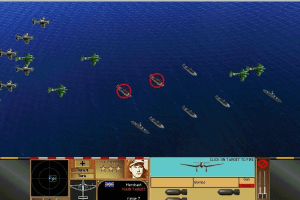
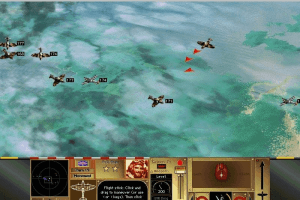
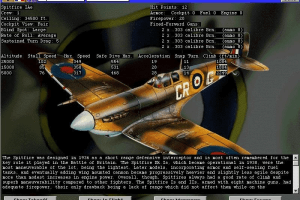
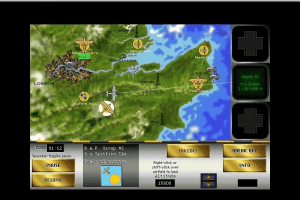





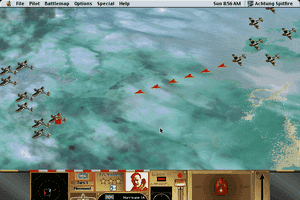
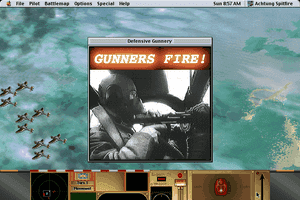
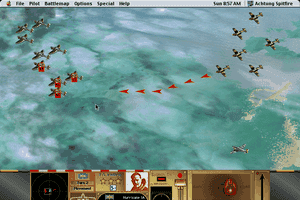
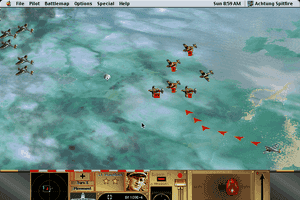
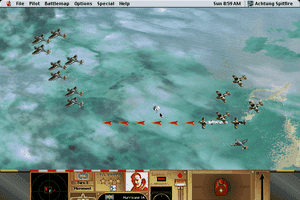
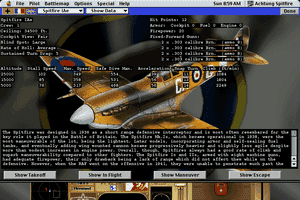
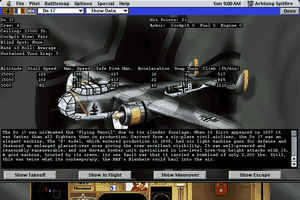
 20 MB
20 MB